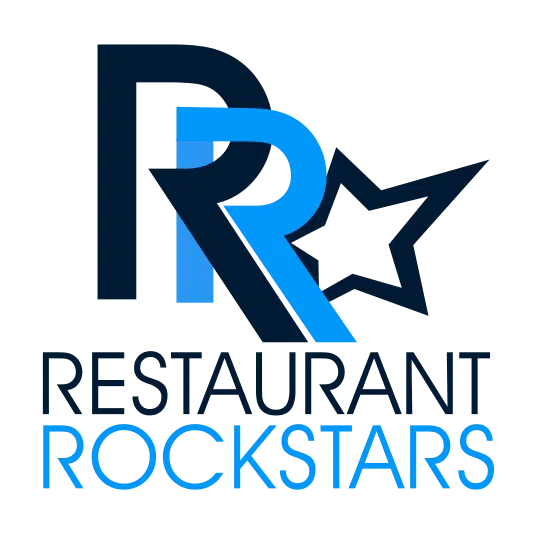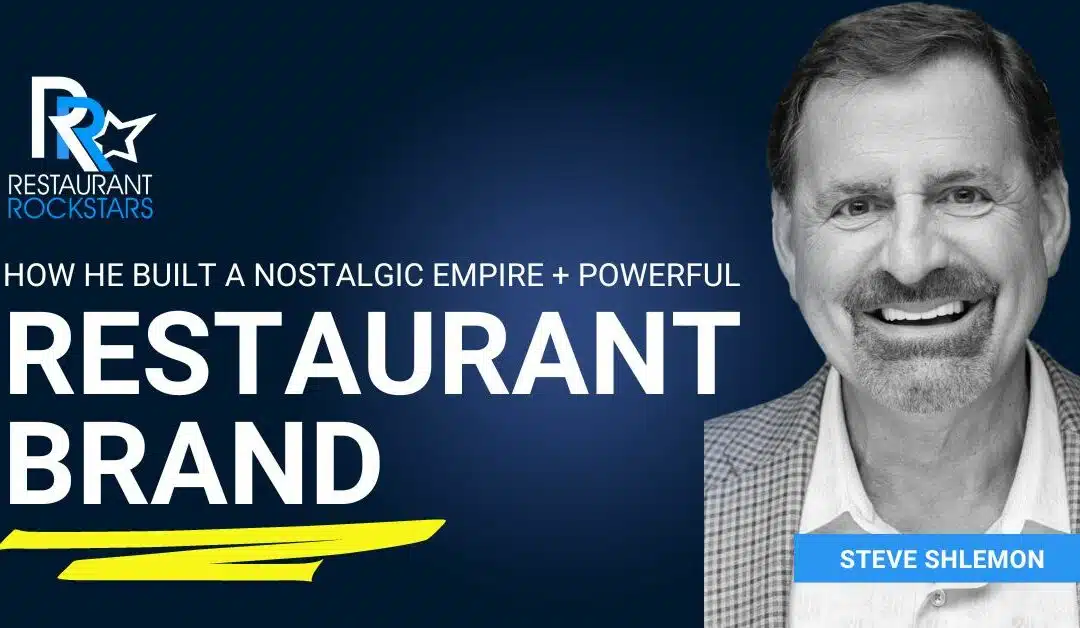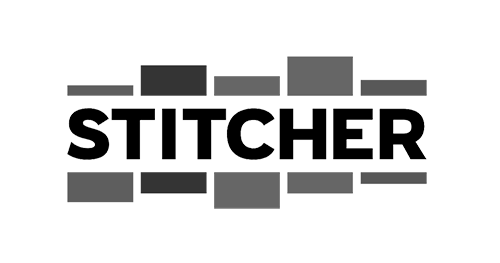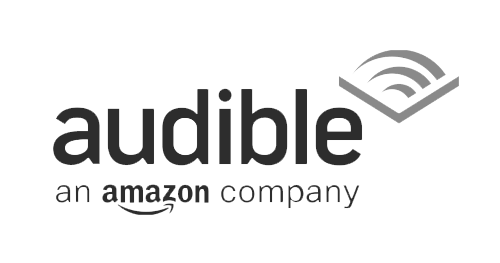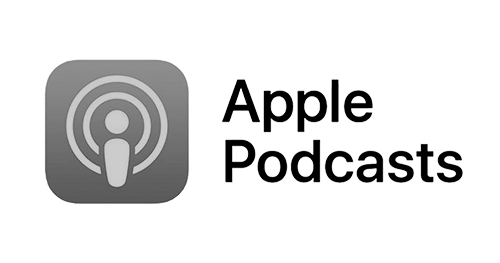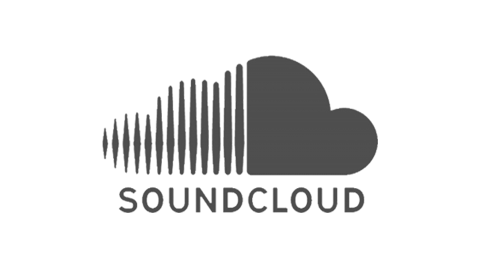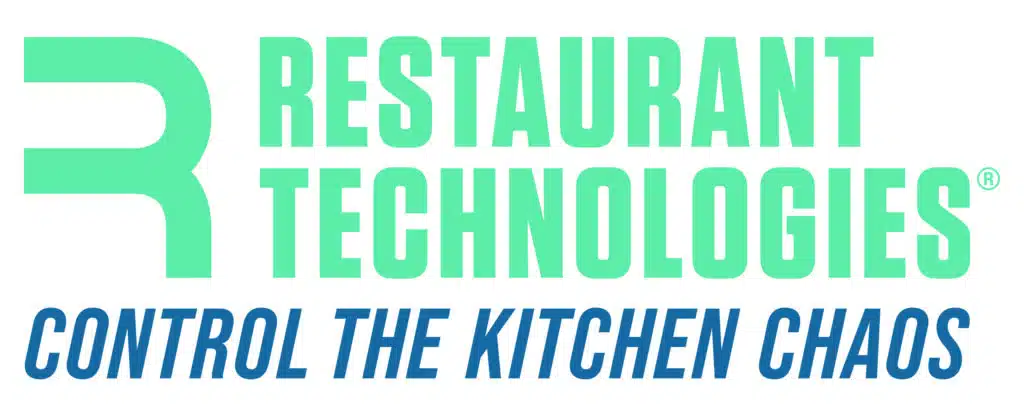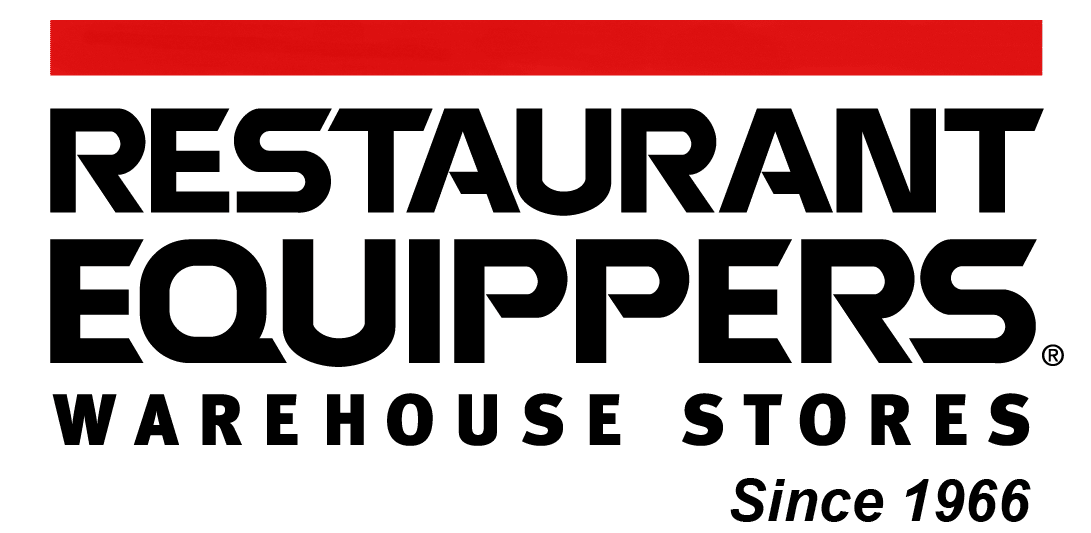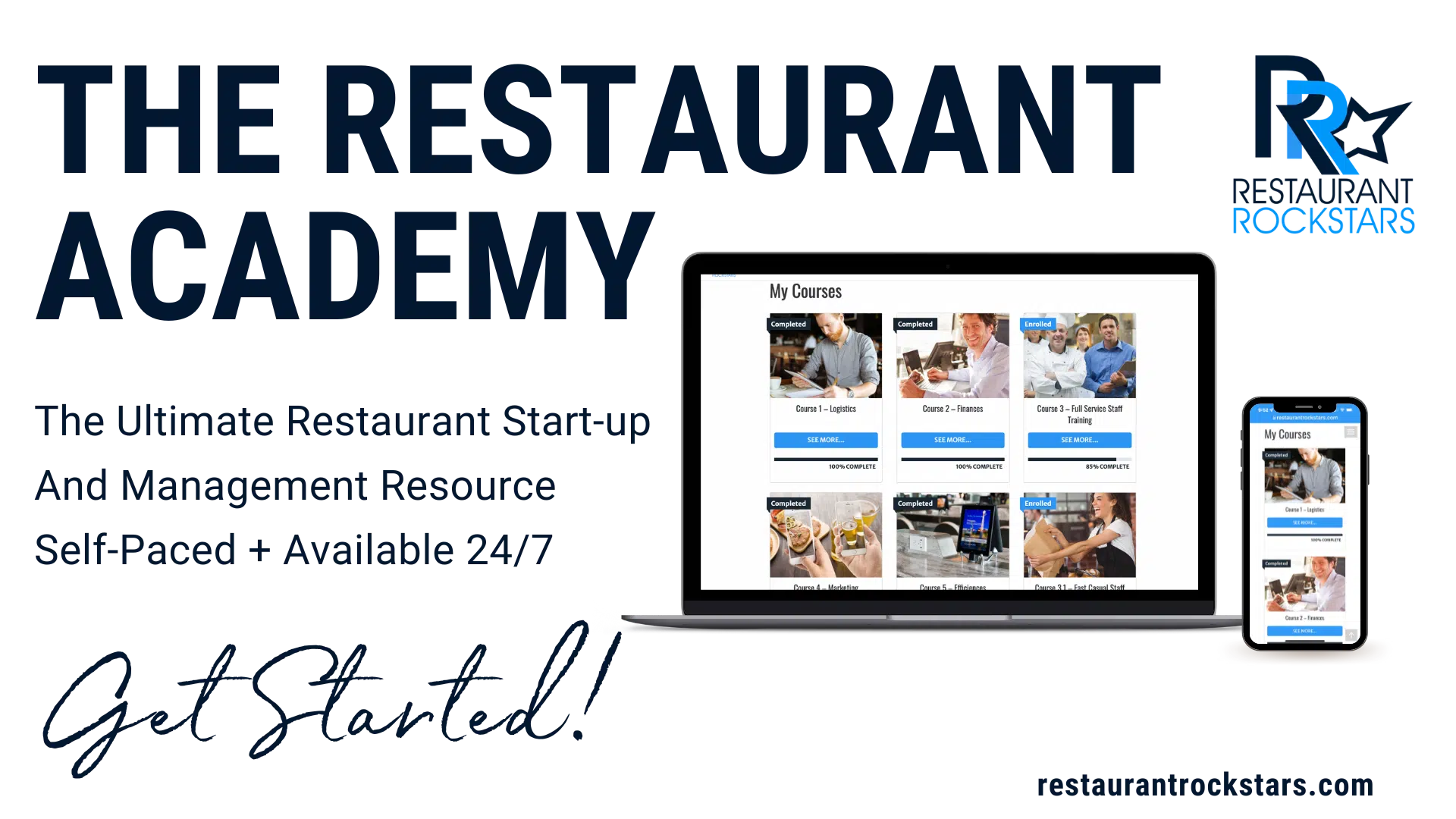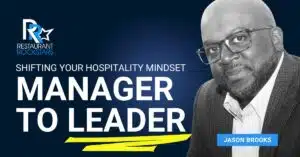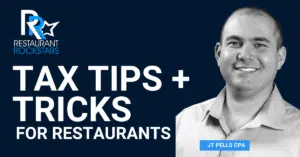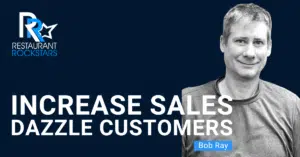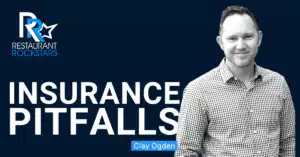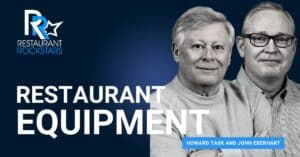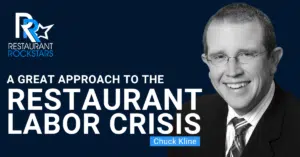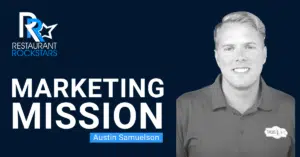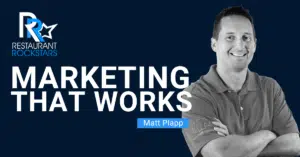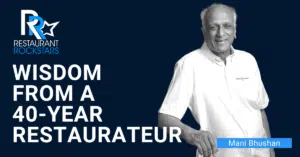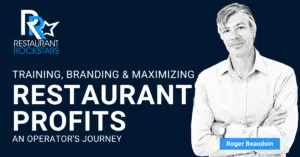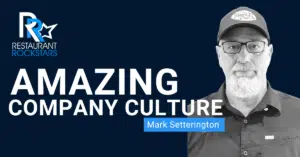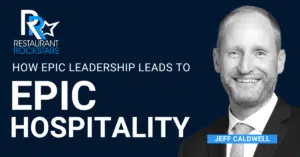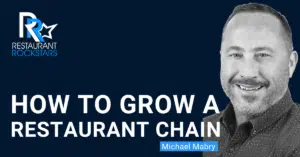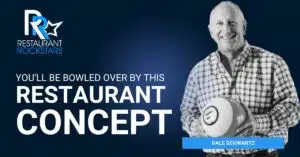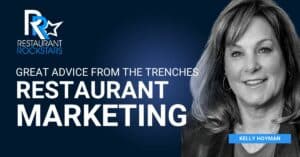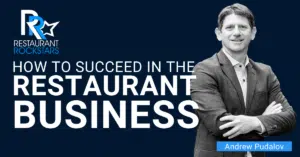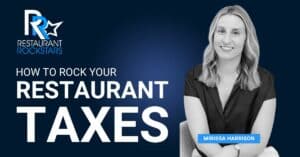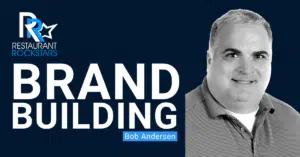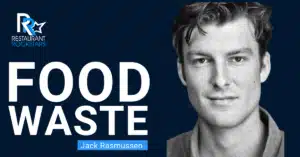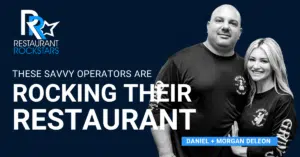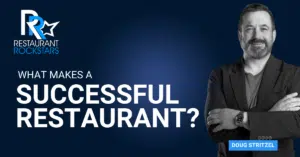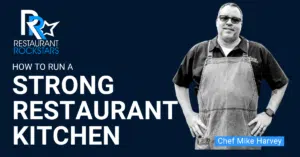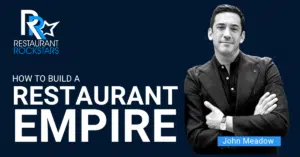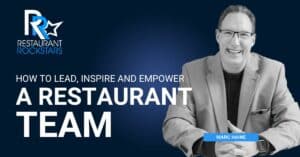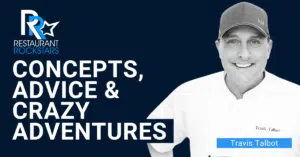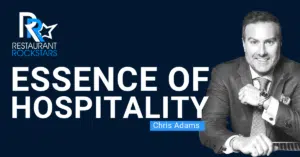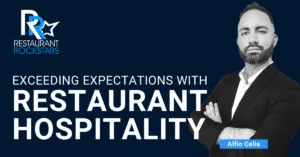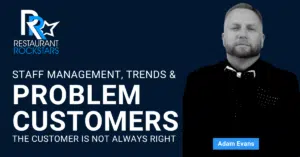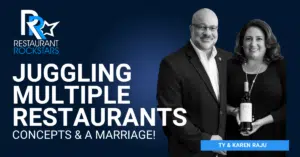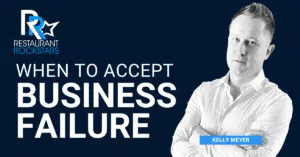Restaurant Rockstars Episode 389
Building a Powerful + Nostalgic Restaurant Brand
LISTEN HERE OR ON YOUR FAVORITE PODCAST PLAYER
Are you running a restaurant, or a business? Are you building a powerful restaurant brand?
These are powerful ideas to consider for true restaurant success.
This episode of the Restaurant Rockstars podcast features an in-depth conversation with Steve Shlemon, the President of and a key figure behind the successful restaurant chain, Ford’s Garage.
Born out of a passion for the Ford Motor Company’s rich history, Ford’s Garage melds the worlds of automotive nostalgia with culinary delight, creating a unique dining experience that appeals to a broad audience.
Steve shares his journey from his early days in the restaurant industry in Chicago to the conceptualization and fruition of Ford’s Garage.
The discussion delves into the brand’s origins, its partnership and licensing agreement with the Ford Motor Company, and the innovative strategies employed to enhance customer experience and maintain brand relevancy.
Steve also talks about the challenges of the restaurant business, including navigating the labor market, leveraging technology to improve service efficiency, and the importance of local marketing and community engagement.
The episode showcases how Ford’s Garage has become a model of how thematic branding, when aligned with quality and service, can create a compelling and enduring dining destination.
We discuss the challenges and strategies of managing a restaurant chain, emphasizing innovation, staff training, and maintaining affordability.
Additionally, it expands upon broader industry challenges post-COVID, focusing on finding staff, technological advancements, marketing strategies, financial monitoring, and the vital balance between technology and hospitality for sustainable success.
Listen as Steve talks about building a powerful restaurant brand including:
- How a powerful restaurant brand captures the guest’s attention and creates lasting impressions across the restaurant.
- Why nostalgia sells, and what is old is new again
- How licensing a famous name leads to lines out the door
- How to attract your ideal “target audience”, re-kindle their memories and serve up “experiences”
- Training staff to represent your restaurant brand and be their own brand in your restaurant
- Why unique menu names ring the cash register
- The most important key-performance financial indicators
And of course, scaling a business from one location to more once you’ve created that powerful restaurant brand.
Listen, I’ve been talking about our Restaurant Profit Maximizer… it’s a powerful course that can immediately boost your restaurant’s bottom line!
For just $7, The Restaurant Profit Maximizer course will show you proven ways to boost profit in your restaurant. Check it out here https://restaurantrockstars.com/profitmaximizer – Then, go Rock YOUR Profits and YOUR Restaurant!
Roger
Connect with our guest:
Welcome back to the podcast. You’ve heard me say this before, but I’m a huge believer in not running a restaurant, but running a business and building a powerful brand. Keep that thought in mind. In order to do that, you really need to deliver experiences to your guests. Know also that nostalgia is big, everyone gets sentimental about the past, and what is old is now new once again.
In this episode, I’m speaking with Steve Shlemon. He is the president of Ford’s Garage. Steve has taken nostalgia to the next level. We’re gonna talk all about the power of brand building and super powerful marketing ideas.
We’re gonna talk about delivering experiences to guests and how they train their staff to represent that brand well. All the ins and outs of running restaurants are in this episode, so you’re not gonna want to miss it. You’ve also heard me talk about our mini course, the Restaurant Profit Maximizer. Now, for less than the cost of a fancy coffee or a craft beer, we have a course that’ll teach you immediately actionable ways to move the needle on your bottom line and increase your profit.
You don’t want to miss that, so check out the link in our show notes to this episode. It’s really gratifying. I just got this awesome testimonial from someone who just went through the course. Lisa H. reports, Hi Roger. I just finished your Restaurant Profit Maximizer course. I thoroughly enjoyed it and learned so much.
I just wanted to thank you for what you do. We’re about a year and a half from opening, but when we get closer, I will definitely subscribe also to Restaurant Academy. So don’t go anywhere. Thanks so much, Lisa. Lisa obviously sees the value of this course. She’s going to put all the pieces in place as she opens her new restaurant.
So again, check out the show notes this episode for the link to that. Now. On with the episode.
You’re tuned in to the Restaurant Rockstars Podcast. Powerful ideas to rock your restaurant. Here’s your host, Roger Beaudoin.
Listen, from one restaurateur to another, and I hope you GMs out there listening as well are paying attention, you know, marketing should never be an experiment, oh, I tried this or I tried that, no, any of your valuable dollars that you spend on marketing should absolutely be trackable, you should know exactly what you’re doing.
where the business is coming from, and that it’s driving return on your investment. You spend a certain amount of money, you want to make far more money in return from that marketing, if you can track it. So pay attention. My friend Dyson runs a business called The Birthday Club, and his program is done for you.
Because we know that everybody dines out on their birthday. It’s a tradition. It’s a celebration. But not only do they not come in by themselves, they bring many friends with them. They usually have free spending and large check averages. It’s very profitable business. So why leave it to chance? Why let your competitors get all the birthday business?
So again, the birthday club is a done for you program. All you have to do is check out www.jointhebirthdayclub.com/birthdayRockstar. It’s a great program. If I still owned and operated restaurants today, after decades, it’s something I would definitely be doing,
so check it out. www.jointhebirthdayclub.com/birthdayRockstar
Rockstars, in my restaurants the fried foods were cranking out of the kitchen, but dealing with the fryer oil and cleaning hoods from all that grease, what a hassle. Not only the high cost, but the mess of changing and recycling oil, scheduling cleanings, you’ve got more important things to run a great restaurant.
Well, that’s where Restaurant Technologies comes in. They serve 40,000 restaurant and hospitality customers in 41 major markets across the U. S. They handle everything, end to end, from delivering, filtering, monitoring, collecting, and recycling your waste cooking oil. No more mess, safety hazards, workers comp claims, or fried food quality issues.
Plus, this frees up your labor, and the cost, to work on what matters putting out the best food. Restaurant Technologies also eliminates the need for scheduling third party hood cleanings. AutoMist can reduce the risk of fire with automated hood and flue cleaning, hassle free. Restaurant Technologies customers can save 10-15 percent on their insurance premiums and even get bonuses for any new customer referrals.
Control the kitchen chaos with Restaurant Technologies. Go to rti-inc.com or call 866-399-3639 to get started today.
Welcome back to the Restaurant Rockstars podcast. Thank you, audience, for tuning in. Steve, welcome to the show. How are you?
I’m doing great, Roger.
Glad to meet you.
This is really exciting because we’re talking about a concept here called Ford’s Garage.
And I’m really fascinated by that because it’s all about the Ford Motor Company and its antique history that started obviously with Henry Ford and the Model T and it goes on to that. But why is it near and dear to my heart? I was born in 1962 and that year my father was the president of the Western Massachusetts Model A Ford Restorers Club.
My whole childhood growing up was the Model A Club, and parades, and shows, and big events, and all that kind of stuff, and this is actually a model of my father’s Model A.
Oh, that’s beautiful.
This is old because they presented him with this in 1962 and I’ve taken care of it all these years, but yeah, you’re the president and here’s a model of your car and all that kind of stuff.
But that was my childhood growing up. So the rumble seat and all that kind of stuff. So anyway, with that said. Let’s talk about your hospitality backstory, Steve. Did you work in restaurants a long time ago when you were a kid? Like, where did the hospitality passion come in and how did you come to found Ford’s Garage?
And we’d like to hear the whole history.
Yeah, you bet. So yeah, I’m from Chicago, born and raised in Chicago. I started working in a buddy of mine’s German restaurant. On Chicago when I was 10 years old. So that would have been 1969, long time ago.
Yeah. Awesome. And
I got introduced to it by washing dishes and then learn how to prep and learn how to cook and just grew up in a family business, a friend of mine.
So through all those years of starting there then I worked at Steak and Ale, which is a long time ago.
I remember that concept, Steak and Ale.
We started the Bennigan’s brand in the early eighties. And so I worked there also for a long time. Did a little stint with TGI Fridays, always in hospitality.
And then the Outback Steakhouse brand was started in Tampa, Florida in 1988. So I started with Outback when they had two restaurants. As a franchisee of the Outback brand, then we acquired Carrabba’s and Bonefish and Fleming’s and whatnot. So when I started there, we had two restaurants. When I left, we had 1, 400, 25 years later.
Wow. I’m familiar with many of those brands. I’ve eaten in a lot of those brands. Wow, quite a history there. And you’ve got quite a bit of experience in this business.
I’ve
been doing it for a long time. It’s a great business. Hospitality is it’s a challenging business, but it’s also a lot of fun and rewarding at the same time.
We talk about this from time to time, but so many young people get their start in restaurants and some of them use this as a stepping stone to other places. You develop life skills, interacting with people, customer service skills, all those things can serve you well, but if you make it a career, I’ve found that you really don’t need a formal education.
You just need that passion. You need fire in your belly. You need to be always open to learning new things and apply those things and then really set yourself apart in an organization to show people that, hey, I’m going places. I like this business. I want to stay here. Where can I go next? What additional responsibility can I take on?
And I’ve got numerous stories from my own restaurant career of people that worked for me that 15 year old dishwashers becoming owners of their own restaurants and all that kind of stuff. So I’m sure you’ve seen a lot of that along the way as well.
I have. And it’s interesting because you, people start off in the restaurant business when they’re young, usually going to school and they have work in the restaurant space as a part time job.
And then they say, eventually I’m going to leave here and go get a real job. And I’m like, I guess in my position, I’ve never got a real job because I’ve always stayed in the restaurant space.
They also say that if if you love what you’re doing, you’ll never work a day in your life.
So maybe you don’t have a job at all. You just have a passion and an avocation, but that’s awesome. So we’re like minded. I love talking shop with fellow operators and you’ve got a fascinating history. Let’s talk about the history and the brainchild for Ford’s Garage. That’s got to be a fascinating story also.
it is
So we started in 2012 in Fort Myers, Florida by a couple guys that were car enthusiasts. , who also operated a small little restaurant in Fort Myers and Henry Ford’s Winter Home was in just off of downtown Fort Myers, Florida. So it was about a half a mile from away where they went open the original one and they came up with the name Ford’s Garage in 2012 without the permission to use it.
But they use it anyways thinking that they were smart local and nobody’s gonna pay a lot of attention to ’em.
Sure.
So they opened up their second one about a year and a half, two years later. And then they got a phone call from Ford Motor Company, but not from the legal department. They got a call from the licensing department saying, one of our people visited your restaurant.
They liked it. You’re using the name without authorization, but we’d like to figure out a license agreement with you guys. Cause we love what you’re doing.
Oh, that’s fascinating.
Yes. A little luck there because it could have gone the other way and said, pull the name, you’re not going to be authorized to use it.
Yeah, that’s a really good idea that you’re bringing up here, because you can come up with a name, and if someone else has it trademarked, you’ve built some sort of a business over time, like in this case, it was almost two years, and then all of a sudden you get the cease and desist letter we’re gonna sue you unless you drop the name, and then suddenly you gotta pivot pretty quickly, and you’ve built a brand around something, and then it’s gone, it could have gone either way, but now that’s fascinating. Did it cost quite a bit of money to do this licensing thing, or is it a give and take because we’re promoting, you’re promoting the Ford brand, like how did that work?
Sure. So Ford has a lot of license agreements with a lot of different retail partners.
They did not have one with a restaurant partner, so we were able to work out a royalty agreement that we pay them a percentage of annual sales.
Yes.
For the use of their name, but they also give us access to some of their memorabilia. We do work with the Ford Motor Company Marketing Department on co doing some marketing events around the country.
So it’s a great partnership and of course, it’s an iconic company that really enjoy working with.
So do they have the historic archives of the 1920s and 1930s things that you decorate the your different stores with, or do you still source that stuff at swapmeets and online and eBay and all that kind of stuff?
And you come up with automobilia, they call it, right?
Automobilia. Yeah, it’s interesting. I don’t think, and I found this fact interesting that, Before 1930, Ford, Henry Ford, had produced over 15 million Model T automobiles. So if you go back 15 million a long time ago, there are a lot of them around the country laying in a lot of garages that people just forgot about that are still there.
So we do have a gentleman who is based in Fort Myers who actually travels the country, picks up the cars all over the country, brings them back to his warehouse. Pulls the engines out, pulls out all the pieces out of it. We take four to five cars and put them in every one of our restaurants. And then all the parts, original parts from the cars are what we use to decorate the inside of the restaurant.
So they’re all authentic and real.
That’s
fantastic. I love that. Very similarly, I had a concept many years ago that was all about Americana, or antiques and memorabilia, and we had a, we recreated an old fashioned gas station inside the dining room, and there was a window that had old fan belts in it, and oil cans and all that kind of stuff, and there was a service station sign overhead, and there was a door that you used to enter, and the repair bay, and all that kind of stuff.
And then we actually found a junk Pontiac Chieftain from like 1951 and we pulled the hood and the trunk and the doors and we hung all that stuff in the ceiling. So not particular to Ford per se, but the gas station concept. So people love that. It’s like guests really coming in and In some cases, it’s nostalgic.
If you’re of a certain age and you remember the Model T’s and the Model A’s, then you can totally relate. But kids must love it too, right? Because it’s a novelty for kids, so it’s a family oriented concept. And I think there’s a message here about branding. I think that’s tremendous. Yeah there is.
Yes, I think, we do have the older grandmother and grandfather who come in the restaurant, they bring their grandkids in, and they introduce them to The history of the cars they grew up with or even their parents grew up with and it’s very interactive inside the restaurant You know the tires actually spin on the cars that are over the top of the bar We have the original horns that the kids can come behind the bar and press a button and the horns go off Smoke comes out of the back of the car.
So it’s very interactive. It leads to a great vibe and great energy and we find it as an escape place for people to get away from everything else and coming in and then for everybody to sit around the table from all generations and talk about the history of cars and automobiles. It’s very it’s really fascinating to see when everybody comes in with quite extended families and to talk about.
That’s terrific. Is there a certain target demographic that is your traditional guest, or is it just literally all walks of life and all people that either hear about it, or they like it because of the menu or the concept is, how would you describe that?
Yeah, it is all walks of life. It’s casual.
It’s come as you are unpretentious great quality food all the way through with great quality ingredients. We have high energy and vibe in the space, but it’s, probably attract a little bit more of the blue collar worker that’s out there, people that love the American dream, that work really hard for their money and want to come in and spend it in a great nostalgic way.
historic restaurant brand that’s built out there. So we hear a lot of stories from a lot of people that come and they just like the casualness of it, but also how approachable it is and it’s very unpretentious.
That’s wonderful. I have to dig back into history a little bit because A lot of people may know about the Model T and obviously they built millions of those and that sort of pioneered the assembly line for American manufacturing.
And Henry Ford had a famous comment. I think you can have it in any color as long as it’s black. And every Model T was just black and they had different models of course, and some were four doors and some were two doors. They were called Tin Lizzies and all that kind of stuff. And then all of a sudden, I think Henry Ford’s son said, Hey, we’re going to be left behind unless you adapt and move to a new style of car.
And I think Henry, the father was adamant about that, but the son convinced him. And then suddenly these Model As had really bright colored wheels. I remember oranges and greens and really. Amazing. But the fenders were all black. The body color were various colors. They built the Model A’s in 10 different variations.
There was a pickup truck and there was a woody wagon and there was the roadster and the deluxe roadster. And that’s what we had, and all that kind of stuff. But what a dramatic departure from the Model T to the Model A. And I think some of your stores may have some of those bright wheels on those Model A’s.
I think I saw it on your website. So a little history there, but it’s really bringing me back to my childhood. So I’m really happy to talk to you. We do have a lot of that.
I think the thing that’s fascinating about Henry Ford and the whole Ford Motor Company was they continue to innovate constantly over time.
They never stood still about anything. The amount of patents that they have around the world there are fantastic. And I think that leads to what we try to do in the restaurant space, which is how do you keep moving your business forward little by little, staying true to the core, but you also have to innovate and continue to move it along.
So it becomes, it continues to be an exciting brand for people that want to go to.
Another excellent point because so many restaurants that might have been around for decades did not stay relevant as the demographic changed and people became younger and, the older crowd died off and now suddenly a 30 or 40 year old brand is gone because it just didn’t keep up.
So obviously innovation is a very important point and always staying relevant with your audience, even if that audience changes. It’s had a theory when I ran restaurants, it’s like the amusement park theory is every year you need a new ride to keep people coming back for more, so it’s okay, what are we going to do next year? What are we going to do now to keep things fresh? Don’t fix what isn’t broken, but always keep innovating and coming up with exciting new things and making sure you market that to your guests and stuff. So I’m sure you’re doing all of that.
Let’s talk about brand building because this is a true brand. And it’s interesting because we talked about the gas station, the logo, the colors the car parts hanging. I understand the faucets in the bathrooms are like gas station nozzle. From the gas station pumps and all that kind of stuff. Like you’ve thought of every single detail, the blue shop towels.
The staff are wearing, the old work shirts from the assembly line workers. It’s you’ve really all the details are there. It’s awesome.
Yeah. There are a lot of great brand attributes that we have in, in, And to your point on little details, I think we have it’s a funny story we tell all the time that a lot of people will go to the bathroom and take pictures inside the men’s bathroom and women’s bathroom, which is a funny story to talk about because who takes pictures in the bathroom unless you’re going to, this is maybe another reason why you do it that, but the cool inside.
And we have a lot of people posting on Instagram, just the sinks. And like you said, the gas pumps for water. A lot of little detail throughout the whole restaurant that really, if you stood there and came in five or six times in one week, you would probably see something different every time you came in that you didn’t notice before.
So another point it’s literally free marketing when you create photo ops inside your restaurant for your guests, and then they share it to their followers who share it to their followers and things go viral that costs you nothing. And it’s like free promotion for your brand. So that’s happening a lot also.
That’s tremendous. That’s cool. Yeah. I’ve always had this mantra. It’s don’t run a restaurant, build a business and build a brand. And that’s certainly what you’re doing. So you’re in six states now, right?
We are in six states
now.
Yeah. Soon to be eight. We’re getting ready to go into construction in Long Island, which will be open up here in the fourth quarter of this year.
And then we’ll be going on construction here in about four weeks in Richmond, Virginia will be our first restaurant in Virginia also.
How many square feet is a typical store and how many seats are they? Do they all vary? Are they all following a template?
No, they all vary. Some of them are from the ground up, but we do take a lot of second and third gen locations that have closed and then remodel them.
We’re anywhere between 6,300 square feet up to 9,000 square feet. Depending on what the building gives us. And we seat anywhere from 200 to 240 people per restaurant. So they’re a little bit large, we do very high volumes on Friday, Saturday, and Sunday brunch. So we need the space for for the people that come in with their large families into our restaurants.
So are you doing two day parts every day? Is it a lunch and dinner type thing? We are. And then you’re doing brunch, obviously. Brunch on Sunday. Yeah. Oh that’s tremendous. Company owned stores at all? Are they all franchised now?
Yeah, so we have one restaurant in in Dallas, Texas that is a joint venture with us and another partner, so we do own half of that restaurant.
The rest of them are all franchised so we’re continuing to expand their franchise network, and then we’ll be building more company restaurants in the state of Texas this year also.
Fantastic.
And ultimately, you’re going to take this across the country?
Ultimately, we are. We have a lot of interest in a lot of states right now from future franchisees, so yeah, the potential for it around the country is huge.
It’s a very, like I said, casual. The other thing I think that’s very important about the brand is the price per person that we look for. So high quality food in a casual environment that a family of four can come in and eat for 100. And that’s hard to do in today’s world to be able to do that.
But it’s really important for us to make sure that our price per person maintains something that, that
everybody can afford.
So that’s interesting. Obviously with inflation and rising costs, it’s like, how do you maintain your margins?
That’s been the biggest challenge for us, especially
on the labor side.
The labor continued to go up. We have had to take a little bit in pricing, but we also work a lot with our vendor partners to make sure that our prices stay, they go up a little bit. They stay somewhat stable because our conversations are always, whatever price you give to us. We do have to pass it along to the consumer and we’re very careful to do that because I think as everybody knows when you raise prices traffic declines in these restaurants so you got to be real careful that your comp restaurant sales might be positive but your traffic is negative and it’s typically because only you’re only gaining it because of price and what it does is it pushes certain people maybe out of your restaurant segment because they can’t afford to go there anymore.
So we spend a lot of time talking about pricing and making sure we’re careful about what we do.
In the past or the recent past, have you had to alter your menu significantly because certain things have just spiked and you really can’t continue to offer the value to the guest?
We have. So we have removed items from the menu before.
A good example, we used to serve a lot of lobster macaroni and cheese. It’s a great item, but the lobster, it’s got so far out of line that we couldn’t afford to put it on the menu anymore and keep it. So we ended up having to take that item off the menu, even though we sold a lot of it, but in order to price it appropriately, we knew that nobody was going to pay for it.
Yeah, we look at it all the time and it happens or the supply is not there that we can’t get the right item that we want to have spec wise. As we went through COVID, a lot of supply chains got shut down. We just couldn’t get the quality items we were looking for, so we had to pull it off the menu.
Do you travel much around the country and pop into stores and kind of secret shop them or is that somebody else’s wheelhouse?
I do it every week. That’s
part of the job. Traveling the country and visiting with your partners and meeting customers and just making sure that everybody’s showing everybody a great experience in all of our restaurants.
So you’re the president of Ford’s Garage. Is there a typical day for you, or how would you describe your primary role week to week?
Rockstars, when I needed equipment for my former restaurants, I called Restaurant Equippers. Restaurant Equippers has served independent food service operators just like you going on 60 years. You’ll find all the top names and extensive inventory at their huge warehouse stores in Ohio, Michigan, and New Jersey.
You can shop Equippers.com or call their National Order Office at 800-235-3325. Their experienced specialists will help you get the best equipment and supplies and save you money. Thousands of name brand products are available for immediate store pickup or shipment. Just like me, when you need something, you need it now.
Restaurant Equippers will make sure you get the equipment and supplies you need, when you need them, at a price you want to pay. They shop the world to find the best products and value. Give Restaurant Equippers a call for all your equipment and supply needs or check their website, equippers.com.
I don’t know if there’s anything typical in the restaurant space of what we do. A lot of conversations with with franchisees to make sure that they’re, our responsibility as a franchisor is to help them be successful and make money. So how do we keep working with them to make sure they’re building great restaurants they’re getting great returns on their investment, that their limited partners are happy that our customer experience is top notch every morning we read all the customer feedback that we get around the country and, we react to that very quickly.
But a lot of time spent in, in the field taking a look at what, we also have 17 different testing models happening in our 25 restaurants today. Yes. We test different menus for pricing, we test different lunch options, we test different happy hour specials we test different loyalty programs.
So we have a lot of things out there that we test on the consumer just to see what kind of feedback we get from them.
So how does that work? Is it a focus groups is the typical way of doing that. Do you do focus groups or is it an advisory board in different states with people that are fans of your restaurant that are, influencers or they repeat visitors?
Tell us more about that.
Yeah, so that’s a great question. So we do invite our loyalty programs, our loyal customers. We invite them in and tell them and say to them, we’ll have something new we’re testing here in the restaurant. Love to get your feedback, come on in, test it. We pay for it for them.
And they’re very open to sit there over a two page questionnaire and fill out everything online for us and give us their feedback about what they love about it and what they don’t like about it. So we’re able to build a database about these individuals. And then we go back in and want to test again in a marketplace.
We have all their information. We send it out to them and they’re very welcoming to come in and tell us since they love the brand, what they love about what we’re testing and what they absolutely hate about.
That’s great
feedback to have from the customer base.
Absolutely. And you can rely on it too. How often would you say let me back up a second.
Are there certain menu items that are literally, sacred that we’ll never, ever leave just because they’re huge customer favorites. So they just fit the brand so well. And then every now and again, we’re rounding out that menu with new items that obviously are tested and focus groups and all that kind of stuff.
How would you describe that?
So we’re about a year ahead. We do limited time offers on a quarterly basis. And we test them in the quarter this year that we’re going to offer them next year. So we’re 12 months up testing in certain restaurants on typically four or five menu items, a couple of different cocktails and then we get consumer feedback about the love the item, they like the plating of it.
There is a price, something they’re willing to pay for it. So we get immediate feedback, so we know a year ahead of time what we’re going to be offering as a limited time special. You have to be that far ahead in order to get the purchasing right and get your training documents right and everything else.
So that’s real important because you have to have new news to tell your customers so you’re not getting stale. So that’s one that’s important. The other thing is there are some items that are really key that, we continue to look at them. The customers do not want us to change. Onion rings are a great example.
We offer some phenomenal onion rings.
Unique name with those onion rings, by the way, tell us the name that, that really jumped out at me. When I looked at your menu, I’m like, branding is part of naming your items, which creates excitement, creates intrigue. And it’s like people order things sometimes because of how they’re named.
What are the name of the onion rings? Again, I just can’t, I don’t know. Remember.
You gotta remember.
Come on now,
something about pistons, I think.
Yeah, that’s
very good. Yes, because it’s served on a long funnel. So the funnel rings. Yes. And they’re very iconic because you walk through the dining room with them on a funnel and they’re all stacked all the way up and they look fantastic.
That is so cool. Again, marketing is such a huge part of any concept, but it’s like there’s so many details to marketing that captures the guest’s imagination, creates an impression, they spread that word, they take a photograph of your menu items, I’m sure, and that can go viral on social media. So these are all tips.
If you’re not doing this as a restaurateur, it’s just a great thing to do if you want to create excitement and, get people really pumped about your brand. So you’re doing a particularly great job about that too.
yeah we are having fun with it
would you say the key, if there’s one thing that stands out what’s been the biggest needle mover on this brand’s success since its inception?
Does any one thing stand out? It’s obviously many things, what is it? Is it the licensing with Ford? Is it the whole concept, the menu? It’s it’s all those things, but anything stand out really?
It is, I think that,
that, and we talk about a lot of it, but the Ford name, the strength of the Ford name when you open up a new restaurant in a city that there is no Ford’s garage, when the blue oval pops up on the outside and everybody wants to come in and see what is the affiliation with Ford Motor Company in this new restaurant that’s opening up, so it does help us tremendously in a brand new market, right?
to have the four name there. Everybody comes in to want to try it out. I think they’re really infatuated once they come in to see the whole overall experience. It’s like a museum moment and an escapism for them,
right?
The ford name helps, but then once we get them in, we’ve got to prove to them that it’s, there’s a reason why you came into our restaurant and let’s make sure we executed all levels.
And We spend a ton of time on, on food quality, execution great people. You have to do a lot of time on training and making sure that people are very thoroughly trained. And we’re in the hospitality business, so you’ve got to be hospitable and, you gotta be friendly and you gotta enjoy your job.
Like you said, it’s not a job. You’re here, let’s have a good time, let’s have fun, work four or five hours, make a lot of money and make people happy.
Absolutely true. Let’s go back to a typical day for Steve. What do you do day to day? And obviously you said no day is typical, but just give us a rough week.
And yeah, you’re at the top of the chain here and you’re in charge of so many restaurants in so many states. And obviously you want everything to be at a certain consistency, the brand performance of each store. Obviously you look at those things, you look at finances, but I don’t want to tell you your job.
Tell us what you do.
Sure. So Monday
Is the whole icon or the whole franchise or team gets together for a couple hours and talks about. how the past week was, any challenges that are coming up, and then we have a lot of conversations more. We spend a little bit of time going backwards, but it’s really about the next 12 months.
Are we on schedule to do everything we need to do as a team? Because in the restaurant space, between marketing, training, construction, design, operations, Everything is all collaborative and everything has to work together. And so your team has to be on the same page all the time. We operate on a simple, business objectives we need to achieve for the year.
We keep it tight, we keep it simple. In the restaurant space, you have to have a lot of systems and disciplines in place to make sure that everybody understands what needs to be accomplished. We as a team then make sure that we’re all on, on where we need to be for that day, and then everybody goes off, I don’t see any of them for another week, because they all travel the country, they get up, they go and then we spend all the time talking to potential new franchisees out there we do a lot of testing, so a lot of the teams will be out there around the country traveling to visit all the restaurants that are testing, whether they’re technology systems to go pick up platforms, Order pay at the table, some new menu items we’re offering, some new cocktails, we’re doing some bar redesign work so there’s a lot of things that are happening constantly up in the air that the team has to then travel around and we spend a lot of time making sure that we’re out there to support the new franchisees.
So it’s a lot, it’s a lot of travel time, a lot of phone conversations, and a lot of talking to customers about how they love the brand and what they would like to see us do in the future.
Awesome. So do you, what do you look for in a new franchisee in terms of experience in the industry and other concepts that they may have started?
It seems to me that it’s at a high level of your expectation.
It is, and they have to have worked in a very successful restaurant brand. They need to understand, they have to surround themselves with, they have to have an awesome management team that has been there, that has done that. I truly believe that you hire above what you need and have the business grow to the capability of the individual you hire.
So you have, you can’t have somebody learn a job once they’re in it at a high level position to have already been there and done that. So we look at them as being extremely strong, operationally sound. They can attract a great. Bench to run a brand new restaurant. They understand the whole philosophy of putting people first and making sure that their employees are put first, and then they’ll take care of the customers that are coming in.
So it’s all about really spending time with them and their restaurants. And I like to watch how a new franchisee interacts in their existing restaurants. If they’re real people focused and detailed, focused, and really have the culture in place that you’re looking for as a partner, they’re a good person to have with you at working in the business.
Excellent answer.
Terrific. What’s the training like? Is there much training when they’re obviously experienced operators, but there’s certain philosophies and systems they have to follow, that sort of thing? Why don’t you tell us? Do they come into a, a test kitchen or a test location and work with you?
That’s a great question. So the franchisee, if they’re the operator and the franchisee, they’ll go through a 10 week, 10 week training program. And it’s not all in one restaurant that maybe work in the kitchen at one restaurant, work a bar in a different restaurant, they go visit the other existing franchisees that are out there.
They go through a new restaurant opening, they see how a new restaurant opening is executed. And we get them fully engaged in everything so that when they get ready to open up their first restaurant. They’re not 90 percent ready. They’re a hundred percent ready to open and operate that restaurant with all the support we can give them.
So the training is quite extensive but you have to know it well enough to be able to execute it and be able to show your people that you’re really a solid operator and it makes sure you’re going to take care of the restaurant the way you want it to.
I totally agree with you. Let’s talk about staff training and onboarding and leadership within the stores.
There’s obviously a high standard and benchmark there as well. So I’m a new employee or a new prospect. What am I going to learn before I’m actually turned loose in front of your guests?
Yeah, that’s a great, it’s a great point. So now, everything now has gone digital or, everything now is being learned through short video snippets.
Nothing more than 45 seconds to a minute and 30 seconds of all these videos for training. So in the old days, we would learn off of paper. Now it’s all done through, through videos, more like TikTok videos that we’re going to share with you. This is how you do a plate. This is how you make a margarita fords garage style and the glass where it goes in.
This is how you approach a table and share with them your hospitality and talk about the menu and everything that’s exciting about it. So the training is pretty robust. There’s a lot of systems you need to follow through. And we also want to make sure that before you go solo to work a shift when it’s in the kitchen, The bar, the dining room, that you’ve actually taken care of one of our managers, had them produce everything that you would want them to produce to show the manager, you know what you’re doing.
Once that’s all done, then you’re ready to take care of a customer who’s coming in the restaurant to pay. So there are a lot of steps along the way, a lot of checks along the way, a lot of tests that have to be taken. And we use a company called Opus that, that helps us with all of our videos and all of our online training and they’ve been fantastic partners to
work with.
That’s excellent. Let’s talk about leadership within a store. Obviously certain people fit into certain positions, they’re happy doing that, but a great leader is someone who recognizes talent in others and then nurtures and develops that and gives them additional responsibility. Is there a lot of upward mobility at Ford’s?
It’s
huge. So I think, we have what’s called garage partners. So each restaurant has a garage partner that actually has a vested interest in his or her individual restaurant. Their responsibility is to train the rest of the staff and management staff to get them ready for future responsibilities.
We love to have a new restaurant open up with half of the team coming from existing restaurants moving up and being promoted. The other half comes from the outside of the community. So yeah, I think you have to have that culture in place that You create an environment where people want to learn, they want to prosper, and they want to move up because they see the pluses of having their own restaurant around the country.
Excellent. Let’s talk about company culture a little bit deeper. You described what it’s like, but can you define it in a couple of words? Like in an example, it was hospitality, family, and fun in my concepts. Do you have a particular culture how you describe it?
Yeah, so it’s very similar to that. It’s all about, it’s about putting people first.
It is about hospitality in the restaurant. It’s quality. Fun has got to be part of it at the same time. So yeah, we have what’s called one for seven. You got one purpose, you have four, four, four goals, and you have seven execution pieces that you need to put into place for all of your employees and for yourself to hold yourself accountable.
So the culture deal is real important to us. And we talk about it quite a bit in the restaurants. It’s, when you walk in, we have to have a safe very positive, clean Thoroughly thought out restaurant environment we want people to work in. So let’s make sure that if your uniform is right and all your stuff is right, they’re going to hold us accountable to make sure they have the right plate ware, glassware, the right ingredients to work with and everything’s got to be done as far as that being a thorough restaurant experience for everybody.
So the culture is critical and they’re going to come back to us when we talk about. quality And if the food that we put on a plate before they serve it to the customer and they don’t think it’s a quality presentation on a plate, we expect them to push it back into the kitchen and for the kitchen to redo it for them.
So if you have that mindset of every one of your employees out there, that whatever they’re going to serve, the customer is going to look at it and they all eat and drink with their eyes. If it’s not perfect, you’re back.
Checks
and
balances. That’s, absolutely. That is so important. We did that as well.
It’s if it’s not perfect, you don’t want it going out to a guest. So
without a
doubt, there’s a reflection on
you. If you’re serving it, then you’re accepting it as maybe not the standard that you want to have, but you’re okay with that. And we don’t want that at all in our system.
Thank you for sharing. Let’s talk about labor challenges. Has that passed in your concepts now? Because every restaurant had struggled with it. Some are still struggling with it. Has people returned to the restaurant industry? Is it easier to find staff now or is that still a problem?
It’s not as easy as it was before COVID.
Yeah.
Definitely, it’s definitely come a long way. So we used to have during COVID, maybe if we had one position available, we would have one person interviewed for one job. Now we’re up to three people interviewing for one job. So they’re slowly coming back. Not the speed we were liking to be, and we’re still behind a little bit more on employees, but what it’s done is it’s forced us to take a look at how do we get some of the labor out of the restaurant space.
Most of that is done through innovative cooking equipment. We test different pieces of equipment that a little bit more easy for me to train somebody who’s never worked in a kitchen before. And so we have that in place in a lot of our restaurants that we see a lot less turnover now because it’s much easier to use some of these new cooking, whether it’s grills or ovens or other kind of flatware that we’re using right now that we find it easier to train and easier to keep people around for a long period of time.
The other thing is technology in the casual dining space. There’s a fine line between technology and customers faces and hospitality. And I think QSR and Fast Casual have done a pretty good job kind of eliminating the hourly employee.
Yes, they have.
It’s hard for Casual Dining because when you come in, you want to be entertained.
It’s an escape place for you. So I don’t want to do all my ordering. I want somebody to do all this stuff for me and I want to have a great experience in your restaurant. So how do we introduce it that it’s still hospitable? And that’s something that we continue to, Casual Dining continues to to be challenged over.
Yeah, that’s the foundational word because hospitality will also, will always be. Paramount with full serve concepts and they should be paramount with quick serve as well, but technology should only enhance hospitality, not replace it. And it sounds like you absolutely agree with that.
100 percent right.
And we’re, and that’s why we’re walked the fine line between what we can and can’t do from a technology perspective.
Let’s shift gears, Steve, and talk a little bit about marketing. There’s a lot of restaurants out there that will experiment and they’ll try new things. And a lot of this marketing isn’t trackable.
There’s no way of knowing, is there an ROI to this, but it sounds good. Somebody calls you on the phone. Hey, we’ll put you on the radio, blah, blah, blah. I’ll try that. I need business, but that’s really not the way to go about marketing. What’s your marketing strategy and plan that’s proven. And let’s talk about loyalty programs.
Give me an overview of marketing for Ford’s Garage.
Sure. So we try and keep it local as much as we can. We have some national programs, so we do work with a great example of a national program is one of, we’re one of the watch spots for the Kentucky Derby. And the Kentucky Derby is sponsored by four motor companies.
Oh, no kidding.
Awesome. Between
us four Motor Company and Churchill Downs, where we know the hundred hundred 50th running is this year. So we’re doing a lot of work nationally with Churchill down to Ford Motor Company. Typically, most of our stuff is done locally. How do we get local into the market?
As far as local schools, we do a lot of car rallies in our parking lot. So we
I was going to ask you about that
yeah, for sure. They’re awesome. They’re great. And so we do a lot of them every Saturday where we can accommodate it. A lot of local car clubs that love coming in the restaurant. The Nollie Ford car clubs, we have a lot of Chevy car clubs out there that come in also at the same time.
So as much local as we can do, we do a lot of SEO or search engine optimization work. We do track a lot of people. Our loyalty club, it’s called the Motor Club. We do have a lot of signups for that, which is great. They do get some perks to come in and sign up on that. We do send them a lot of information on a monthly basis about what’s new happening at the Ford’s garage.
We want them as gauged and as gauged as we can get them engaged.
There are a lot of loyalty programs in some cases that are boring and tired and it’s, there’s nothing new about it, but you have different tiers of your loyalty program. I think I saw the roadster, the speedster, the hot rod.
It’s like there’s different levels of perks and rewards based on how frequent you visit. Is that correct?
That’s correct. And that’s another thing that we’re talking about a conversation this week because we love our rewards program the whole Oli program is neat, but it needs a whole redo and update so to keep it fresh.
And so we’ve had a lot of feedback from customers that said, your levels are really great. But maybe you can have a lower level for us people that are starting off a little bit more to get us more enticing to get up to the bigger levels. So we’re actually in the middle of modifying that program to make it more enticing for customers to want to come in, get more perks earlier on.
And have them become, raving fans of Ford’s Garage because we’ve taken their feedback in, what they’re asking for, we can definitely do from a financial perspective. So we’re going to make some changes to the program which I think is very positive.
Is there a CFO in your organization at this stage that sort of monitors performance in the stores, looks at certain KPIs and figures out and make sure that everyone’s at a certain level in terms of their cost structure and their profitability?
How does that work?
There is.
Yeah, so we have one within the organization. She shares P& L statements with the other franchisees that are doing like sales and we jump on a call every month. We have P& L meetings. We talk about It’s not used as a whip because they’re franchisees, they make their own money, but how can we help them work on some of the gaps that are in there, or do we need to send one of our people in there to help them out a little bit more on maybe some of the things that they’re missing, whether it’s labor scheduling that they’re working on, or some food cost challenges that they’re having, but we’re here to support them any way we can.
So yeah, we go through a lot of financial data on a weekly basis.
Best practices and efficiencies and shared strengths that only makes sense. It does. Keep it simple. Yeah, how about certain key systems? That word’s come up twice now in this conversation. What are the key foundational systems that are important in your restaurants and any restaurant, really?
Yeah, so I think it would be, first thing you have to be is you have to have a great onboarding system and a great training platform for everybody to use. So it’s real important. It’s got to be something that’s digital, that the current employees can operate under. They want it all on their cell phone.
They want all the training materials on a cell phone that it’s easy for them to grab. It’s great for us because we can update the materials pretty rapidly because it’s all done, digitally, which is awesome. So you have to have a great platform and training system in place. You also have to have what we call a prep system that everything is done on prep list or all done computerized in the kitchen.
So if we have some challenges on an out of stock item or whatever, it’s easy for our corporate chef to go in there and Punch a button and say, this item is no longer in stock. Here’s a replacement for this item. So the whole system knows what’s happening immediate. It’s real time. So I think you have to have those in there to help the operator.
So they’re not out there trying to figure out, run to the store and grab an item. Here’s your sub, here’s what’s going to happen with it. So that type of a system, I think is awesome to have in place. I think the other thing is to help support them from the marketing ever. So we’re going to run a limited time offer.
What is the 360 program that’s going to help them push that limited time offer? Part of it is the menu, part of it is training, part of it is how we’re going to get to the loyalty club and talk to them about it, what kind of search engine optimization are we going to push out there either through Yelp or through Google to try and let the other customers know, here’s the new stuff we’re talking about, come in and try it out, it’s only going to be here for 90 days.
Let’s talk about technology, because that keeps moving forward every minute, and there’s every technology under the sun in the restaurant space today, and some is absolutely vital, and some is just that’d be nice, but I don’t think we really need that. What have you found to be absolutely essential in your business from a tech standpoint?
So what you have to have, and that’s a great question, because of this whole Uber Eats, DoorDash, pickup of food.
How do you make that whole thing seamless to the customer? Because if you do that, they’re going
to definitely put you on the list of two or three places they’re going to go use.
So how can I get you to pre order, pre pay, drive up, put the bag in the back of your car, so you’re in and out of the parking lot in 30 seconds. If I can do that for you with great quality food that you take home to your family, you’re going to want to utilize me all the time. So in those systems, we spend a lot of time on building design and on all those platforms.
So You don’t look at our restaurant and say don’t have to go there because you can never get your food if you’re going to do to order a delivery pickup. The other thing was what I talked about earlier in technology. We do have a kitchen system that all the orders fire back in the kitchen on a computer.
That is great because you don’t have any tickets being handed in back and forth to the kitchen. So that leads to speed. And the other thing we’re testing is how do I get you to order at the table, pay at a table using a computer with the help of an hourly employee. So that’s something where we started testing that.
Has some bumps. It’s a little clunky but you have to make it a customer. I would ask you, do you want me to take an order? Are you comfortable using this thing to place your order yourself? The younger people want to do their own orders because they don’t want to talk to anybody. The other people want to talk to everybody and don’t want to do that, use a technology platform.
So we’re playing with that a little bit right now to see how can we make things a little bit more seamless and a little bit more faster for the customer who’s more in a hurry, maybe in the restaurant space that they can utilize the technology.
Yeah, guest convenience and efficiency and helping things run smoother and helping your people put out the product at a higher level of quality and not make the customer wait.
All these things are important, but yeah, keeping up with what’s happening out there and third party delivery and online ordering and all that has been essential. And the pandemic really shifted the way we approached our guest relations and how we provided the service and the quality to the customer.
And now those things are going to be with us forever. When they weren’t pre pandemic. So it’s amazing. As bad as the pandemic was, it did create a lot of innovation for our industry that, that is helping drive things forward now.
Yeah, it did. And it forced you to do something. Maybe a lot of restaurants were never doing that before and they had to, they had no choice
if they’re going to survive.
Something you said, just go back to marketing for a quick second, because something you said triggered a thought and it reminded me of cross promotion. When I had different restaurants, they weren’t all the same brand. I had a Mexican cantina and I had a steakhouse and I had wood fired pizzerias and all this kind of stuff.
And we used to cross promote the individual restaurants. So if you liked us here’s a promotion or something where you can go. Try out that restaurant and get some sort of a deal. Do you do anything with besides the licensing with Ford? And you said that your marketing is local in some cases.
Do you do anything with Ford dealerships where you promote that dealership and then they drive business to your locations?
Yeah, that’s a great question. Yeah, so
we do have in St. Augustine, Florida, we actually are, have a restaurant that’s on a Ford Lincoln dealership property.
No kidding. That’s awesome.
Yeah, so they’re our partners, so we actually built the restaurant in the Lincoln dealership. And they actually own part of the restaurant with us there. It’s extremely successful. We drive about 5, 000 people a month into the dealership who come visit the restaurants or they bring them in and then they come visit our restaurant.
So as a co dealer, it’s been fabulously successful for us. We do have restaurants around the country that we go to the local Ford dealer. We ask them if they want to be one of our partners and invest in the restaurant with a local franchisee. Which is an awesome thing to have. So we sell up to a certain percentage of the restaurant to a local Ford dealership and have them be our partners.
Tremendous. You’ve thought of everything and not that we don’t continue to innovate, but you obviously have a mind for that. It’s what’s next? What can we do? We’ll keep the brand sacred and we won’t change anything that works great. Again, there’s that, what are we going to do next? And staying relevant is, has definitely come out in this podcast.
So Steve, what have we missed? Have we talked about everything or is there something you’d like to share with our audience that I didn’t ask you about?
I’ll tell you, it’s an ever changing business, like you said earlier. And I think we always go back to the, to these restaurant brands that maybe we worked with in the past, whether it’s Steak and Ale or Bennigan’s, or we probably remember Howard Johnson’s and the old Orange Roof restaurant.
Oh my God. That was huge. When I was a kid, we actually had one just down the hill from where I grew up, but my father owned a trucking company growing up the Model A. Ford president guy owned a trucking company with my uncle and I would go on trips in some of those trucks sometimes and along the Massachusetts turnpike there were Howard Johnson’s restaurants between Western Massachusetts and Boston where I grew up.
So yeah, the orange roof and their menu and yeah, it’s gone now for the most part. But yeah, that was a staple when I was a kid growing up. I’ll never forget that.
Yeah, it was, and I think Stuckey’s along the way, right? You probably visited some Stuckey’s restaurants, and if you look at those scenes, they were awesome when we were kids.
And if you go back and you think what changed? If a restaurant becomes a place that your children don’t want to visit, you probably need to take a look at what you’re doing because you just, the older people are going to get older and eventually get out of it. And you have to have the children and the kids along the way have to want to come into the restaurant that your parents used to go to.
Yeah. And then capture their kids while they’re still small.
Yeah. We think about that all the time. You got to keep it fresh and you got to make sure you’re taking it. Not only taking care of you who comes in, but I have to take care of the younger ones that come in that they’re going to want to bring their kids later on.
So it’s a constant evolution and move to make sure that you’re staying relevant, can stay up.
That brings up another point. Do you have any real estate in any of your stores that have the kids candy cranes or the stuffed animal cranes, or, just games to keep them occupied while their parents are enjoying the meal?
And, it’s another profit center in the restaurant, but does that fit your concepts at all?
Yeah, so we do, we have coloring books and crayons. We don’t do anything with computers or any of that stuff. We do have retail on the front of the restaurants that there’s some great retail items that are smaller forged garage shirts that children can wear.
We do glassware, we do dog collars. So we do some fun little things there that keep it interactive. But I think with all these things moving around the restaurant with fans and TVs and the tires moving and The horns, the fog and all that. There’s plenty of things to keep, kids looking around and being entertained by what’s happening within the space.
Yeah, we always called those things hooks, right? What do you do differently that captures the guest’s imagination that also brings out their phones to take pictures and just giving them lots of reasons to come back? Just, yeah, it’s all this is show business, right? It’s entertainment, it’s show business, it’s about great food, it’s about great service, but it’s also about the ambiance and giving them lots of things to look at and just keep them interactive and that’s wonderful.
So you got the magic formula for sure.
We’re working on it. So far, it’s done well. And back to that point, I think you got to keep the vibe and the energy up in the space. We have TVs on, but no TV sounds. We’re not a sports bar. We’re, we’re a family restaurant. And I think it’s a great old, rock and roll music that we play.
And it’s, there’s just a lot of things going back to take you back in time to a different place that It’s fun to watch when a music, when a song will come on and you see a couple of older people and start singing the song and the kids are like, they never heard of it before,
but it’s fun to see.
It is for sure. Steve, it’s been wonderful having you on the podcast. Really appreciate you being here.
Great to meet you. Thank you very much. Have a great day.
And you as well. That was the Restaurant Rockstars podcast. Thanks so much for tuning in. Thank you to our sponsors of this week’s show. Can’t wait to see again.
So stay well and stay tuned. See you next time.
I gotta tell you, it really pains me to see restaurants fail, and it pains me just as much to see restaurants with shrinking margins, with rising costs, and being tied to their business 24 7 because they can’t afford to pay what I call a leader, or someone to help them run their business. And that is so important today, you know, working on your business versus in the business.
I travel the country, I’ve coached lots of restaurants, I speak, I speak to lots of different restaurant people, and I hear the same thing. Why don’t my staff respond to what I expect them to do? Why do they not show up for shifts? Why am I not making any money even though I have a busy restaurant? What can I do about marketing?
It’s like, what’s proven? Now, these are all very logical questions, but the answer really is having a system or a series of systems where all of these things are dialed. I’ve spent 23 years starting restaurants and operating them to success. I’ve been in this business for 30 years, and the Academy is everything I’ve learned about it.
These systems and running a business, not running a restaurant. What are these foundational systems? Cost controls and maximizing profit, knowing your prime costs, knowing what your sweet spot for inventory, food, beverage, and labor costs. These are really, really important things. More importantly, It’s about costing out your menu so that you know exactly how much it costs you to serve every dish to every guest.
That’s the finance piece of the Academy. We have something called Sales Stars, which trains everyone, whether you’ve got a full serve sit down restaurant, or you’ve got a fast casual, quick serve, or food truck, it trains anyone who interacts with a guest every day. Two, recognize opportunity, to have product and restaurant knowledge, to make friends with your customers, and to make suggestions that we all know the guest will enjoy and appreciate.
That doubles and triples check averages. That’s a system in the Academy. There’s a marketing section that is not about an experiment. It’s not about throwing thousands of dollars out the window hoping something will work. These are proven ideas that I used in all of my restaurants that cost very little money But they proved to have ROI.
Best of all, they were trackable. I knew exactly where this business was coming from. And it delivered ROI or return on investment. Even if you’re starting a very first restaurant, this is everything you need to know to literally start your business, open the doors to that business, put the systems in place and run it profitably and successfully.
So now the Academy also includes 25 free memberships for anyone on your team so that you can say, Hey, go to the finance section and learn this, put this in place and I’ll give you. An incentive for doing so. Help you run your business. It’s about creating a real brand and running a business. And everything I’m talking about is in the Academy.
So check it out at restaurantrockstars.com. Thanks so much for listening. We’ll see you in the next episode.
Thanks for listening to the Restaurant Rockstars podcast. For lots of great resources, head over to restaurantrockstars. com. See you next time.
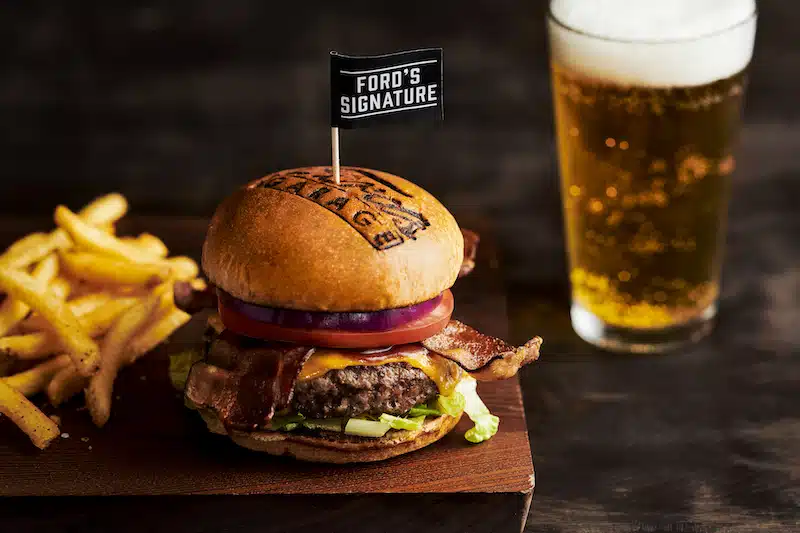
Thank You To Our Sponsors
They handle everything end-to-end from delivering, filtering monitoring, collecting, and recycling your waste cooking oil.
Restaurant Technologies customers save 10-15% on their insurance premiums and even get bonuses for any new customer referrals.
Top equipment brands, extensive inventory, everyday low prices, and 60 years serving independent food service operators.
Did You Know That 7 out of 10 Adults Dine Out To Celebrate Birthdays?
You Can Easily Capture This Lucrative Business!
Want to become a podcast sponsor?
Please get in touch with Roger at roger@restaurantrockstars.com
